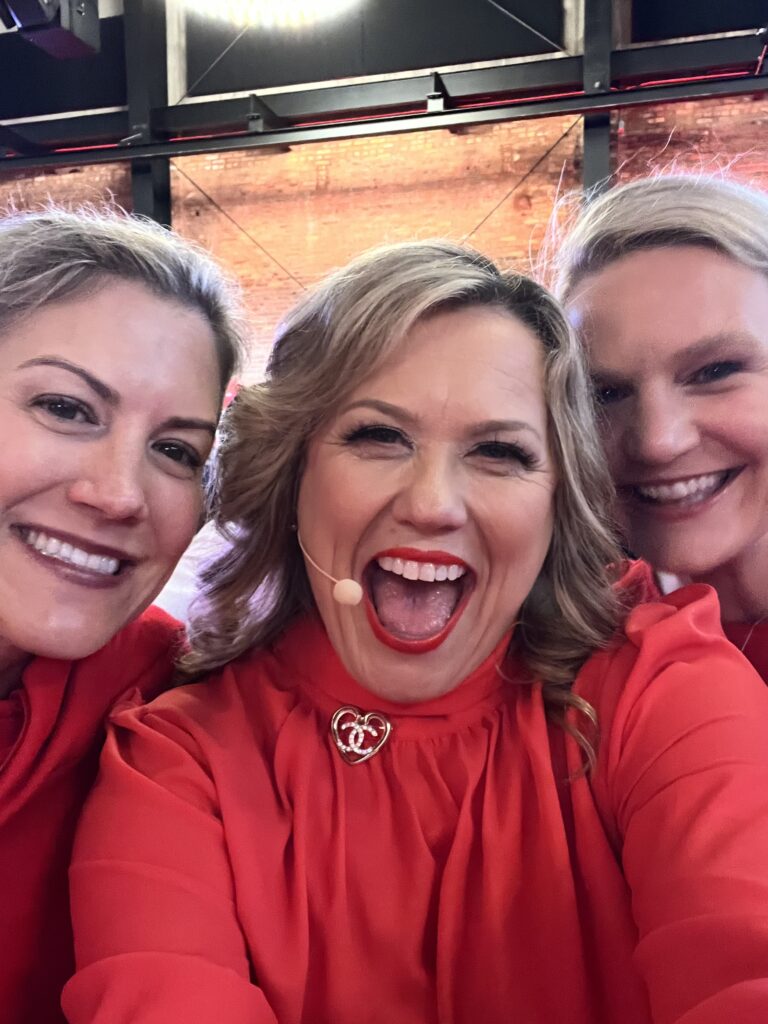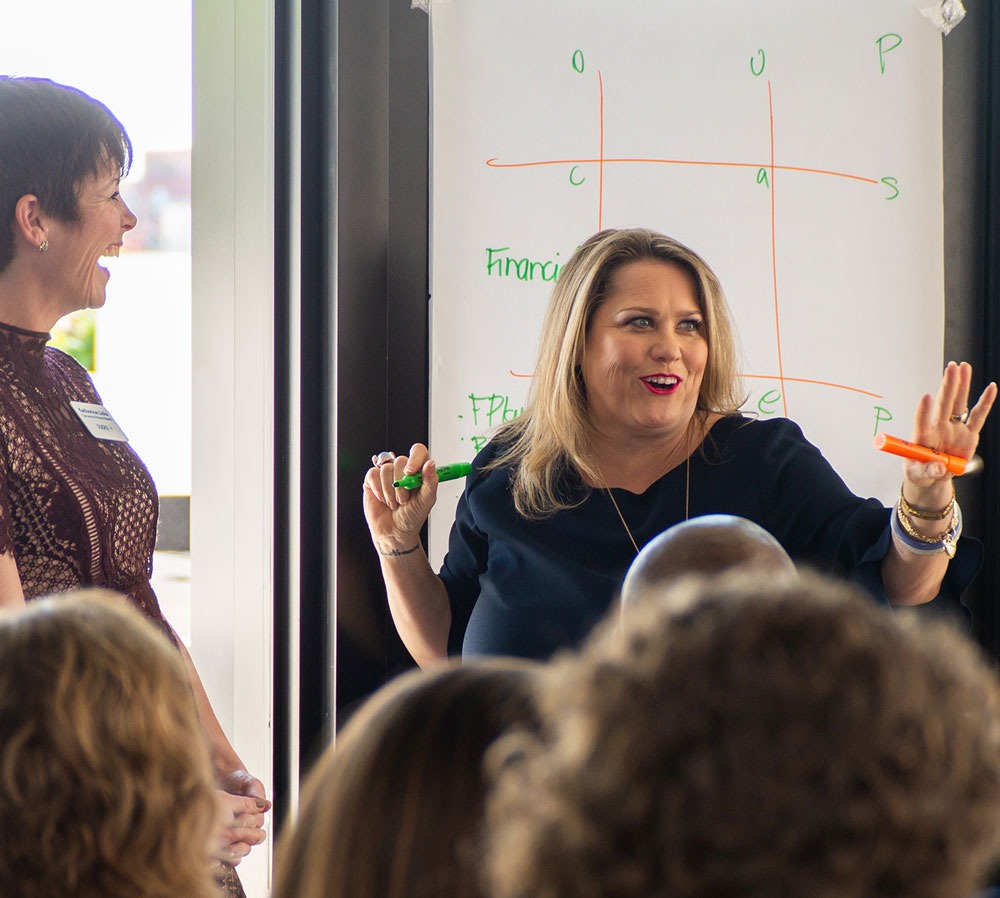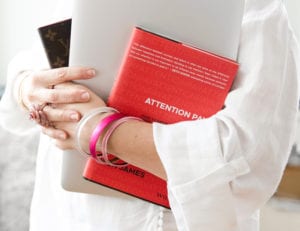
Neen, Jenn and Lauren at Go Red Luncheon Tampa
Over 25 years ago, yes you read that right… I contributed to a great little book called Network or Perish.
It’s funny now reading the title, and when I read my chapter, it still is relevant today.
Below is an excerpt of the book, Network or Perish, curated by the legendary speaker (and the reason I became a speaker, Robyn Henderson; she has since moved more into consulting; she made a significant impact on me).
Networking is as much an attitude and a way of thinking as a skill.
Robyn always said, “Networking is a lot like watching sunrises; if you don’t show up, you will never know what you missed.”
Many people do it naturally, while others may find it daunting, and I promise it can be learned.
When you acquire the mindset and master the skill of networking, you will boost your productivity.
Networking requires an investment of two of your most valuable and finite resources: your time and energy.
In this book chapter (remember this was part of a more extensive book), we will consider how you can best use these resources by choosing the most effective networking opportunities, creating systems that ensure you get the most out of every networking event, and learning how to effectively engage people when you meet them for the first time.
Creating Your Connections
There are any number of different networking groups and events that you could choose to attend. To make the most effective use of your time and energy, it’s worth investing effort in identifying and sampling groups that look like they might suit your personal and business needs – here’s how:
Choose the network.
Decide what you’re looking for from a networking group and ask around. Find out what groups are available and ask for recommendations and opinions from people you respect.
Contact the network.
Phone the group or event organizer and ask questions such as these to help you decide whether this is an excellent place to invest your time.
- What types of people attend this event?
- What industries are represented at this event?
- How long has it been established?
- What three words best describe this group?
- Is there an opportunity to promote my business?
- Does this network have a membership?
- If so, how does it work? What does it cost?
Visit twice before deciding to join.
Allow yourself at least two opportunities to evaluate the network and to decide whether it is worth your time and energy. Sometimes your first experience may not be pleasant, and you may feel nervous, so give it at least two tries.
Commit to the events.
When you find a network you enjoy, schedule the time to attend and become one of the regulars. This is a great way to connect with people and let others get to know you.
Get involved.
Volunteer to help – serving on a committee or helping with an event is a great way to get to know people: help with registration, collect business cards, offer to be the emcee or help to arrange an event.
If you can’t find a networking group that seems to suit your particular needs, chances are other people who share your frustrations – and there may be an opportunity for you to establish your network.
Want to build your network?
Establishing your network can take significant time and energy, but it can also be very rewarding as you provide self- and professional development opportunities through exceptional speakers, watch people build relationships and alliances that they may never otherwise have been able to – and see the regulars coming back month after month if you want to
Determine your focus.
Ask yourself, “What is the purpose of this network?” Understand why you want to establish it and who should be involved. You may choose to specialize in an industry or it might be a group for a specific segment.
Set your strategy.
Understand where you want the network to go, what it will achieve, and how your members will benefit from involvement. Getting a few people to brainstorm ideas with and contribute toward your strategic plan is helpful.
Decide the activity level.
Regular activity is the secret of a good network. Choose a date once a month and always meet at that time.
Decide functionality.
A network requires a significant investment of time, so quickly establish a team of people to help you or a fully functional website to support you.
Get good support.
Ask for a committee of volunteers to help you organize, run and follow up on each event. You’ll find many people are willing to help and get involved if they believe in what you are doing.
Working Networking
Your business card is one of the most essential tools for any networking event. A great business card is crucial; it creates the first impression when you hand it to someone and is a lasting reminder of you and your business every time someone looks at it. What does your business card say about you?
PS. When I wrote this book, no one was using digital cards. I am still not a big fan; it’s awkward scanning phones, and I can’t write notes, and I find that frustrating … does that make me a Luddite? LOL, perhaps, but I still love a physical card.
|
Create Interesting Business Cards
Your business card is your calling card and can be your ‘pocket billboard’. Invest in creating an impactful card that helps people connect with who you are and what your business is. You might do this by:
When I first began in the speaking business, I created a foldout card using an unusual sparkly paper stock. The colors I used were pink and purple, my corporate colors. Every person who held my card commented on its design, color, or feel. I consider the initial expense of design and production as an investment in creating a memorable representation of my business. However creative you choose to make your business card, ensure it adheres to some basics of good design and good manners:
Look at other people’s business cards for ideas and inspiration, and speak with your designer about creating something memorable for you. Ask for feedback on your concepts and designs from various people to get a feel for how different people react to your card before you settle on a design.
|
Getting the most out of any networking event is more than just handing out and collecting cards. Some people seem to think the success of an event can be measured by the number of business cards they take away. The truth is it’s better to make real connections with fewer people rather than to pride yourself on a collection of cards you may never use. These simple steps will help you use your business cards effectively and know what to do next with the cards you collect at a networking event.
Always carry your business card. That means both in and out of business hours – even at social and sporting events; you never know when someone may need your services. Ladies, it is a good idea to keep a supply of business cards in all your handbags, while gentlemen, you may like to keep a supply in all your coat jackets.
Never hand out cards with incorrect or crossed-out information. It is not professional. Information crossed out may give the appearance that you are disorganized or don’t have attention to detail. Business cards are not expensive to print, and you ensure each one you hand out is an ideal representation of you and your business.
Keep a good supply of cards. Don’t allow yourself to be in a position where you can’t give someone your card. Be aware of your stock and reorder before you get too low.
Ask for a business card. When you have met someone and had a conversation ask, “May I have your card?” Always ask for their card first. Once you have received it, ask, “May I give you my card?” Don’t always assume that they will want your card. Giving it to them after they have said yes is more polite.
Ask permission. If you want to write details on someone’s card (while still with them), always ask, “Do you mind if I make a note on the back of your card?” Some people invest substantial money in their cards, and asking this question demonstrates your respect.
Write notes to yourself. When you have finished a conversation with someone, please take a moment to write something about him or her on the back of his or her card. This will help jog your memory when you contact them after the event.
After each networking event, I gathered all the cards collected and put a rubber band around them with notes to remind myself of which event I met them at. I place the pile of cards on my laptop keyboard to action them the next day.
Some people invest in contact management systems, many of which are good. However, you can still establish an effective contact system using essential tools such as a business card holder and your contact system, i.e., Google Contacts or Outlook.
Schedule follow-up time. Whenever I book a networking event into my calendar, I schedule another 30-minute appointment with myself for the day after the event to follow up with the organizers and the people I meet.
Send handwritten cards. I handwrite thank you cards for those people I made a real connection with. I thank them for the time we spent, the information they gave me, or for acknowledging our other connection. Receiving a handwritten card in the mail is so unusual and personal that it delivers a powerful impression, far more substantial than a quick email.
Book a 15-minute coffee. If you have connected with someone at an event and want to know more about them and their business, make an appointment for a 15-minute coffee. Fifteen minutes is an easy appointment for most people to fit into their schedule. It indicates that you value their time and show that you genuinely want to learn more about them. When you contact them, you might say, “I’d like to invite you for a 15-minute coffee so I can find out more about what you do; what day is most suitable for you?” Make sure you honor the 15 minutes. At the 14-minute mark, I always stop the meeting and say, “I promised it would only take 15 minutes, so thank you for your time”. At this point, the person you are with can choose whether they want to end the meeting or continue.
Send a thank you to the event organizer. Take the time to thank the event organizers, let them know why you found it valuable, and include your business card in the envelope. A lot of time and energy goes into organizing events, and people appreciate you taking the time to acknowledge that.
Meeting and Greeting
Another essential skill when you have decided to attend an event or join a network is knowing how to engage people when you first meet them. Meeting new people and conversing can be daunting, but with a few simple techniques, you’ll become more and more comfortable with each new event.
Appear confident. Smile when you first meet someone and look him or her in the eye. Even if you don’t feel it, your smile and eye contact will show the other person you are friendly and confident.
Be aware of your body language. Be mindful of good posture; stand straight with your shoulders back. Don’t fidget with pens or clothing – keep your hands by your side if you constantly fidget. A smile, combined with good posture, will boost your confidence.
Introduce yourself first. Rather than stand alone, be brave. Walk up to an individual or a group, extend your hand, and say, “Hi, my name is Neen James; nice to meet you.” Everyone will respond positively to your confidence and appreciate you making the first move. It will be a trigger for others to do the same.
Shake hands. This is an important skill; learn if you don’t know how to shake hands properly. Cultivate a firm handshake – not too hard, but just right. Look the person in the eye when you shake their hand and say their name aloud: “Hi Robyn, it’s nice to meet you.” If you are unsure about shaking hands with someone, always extend your hand first. It is rude not to shake the hand of someone who offers theirs to you.
Learn how to pronounce their name. When you encounter someone with a difficult-to-pronounce name, ask them to repeat it, spell it, and repeat it – and allow them to correct your pronunciation so you get it right. People will appreciate you taking the time to learn how to say their names correctly.
Use a person’s name several times when you first meet. This will help you to remember their name; it’s a very personal way to communicate – and people love the sound of their name!
Learn conversational skills. The ability to make conversation is what scares so many people about new social interactions; here are a few questions you can ask anyone you meet for the first time:
- What do you do?
- Where do you work?
- Where do you live?
- Does it take you long to get from home to the office?
- What inspires you?
- What do you like to read?
- What has been your most valuable business lesson?
- How did you hear about today’s event?
- What are you most looking forward to about today’s event?
Ask people what they like to do in their spare time. This is a great question, and most people become energized when you ask them about their life outside of work. Watch their eyes sparkle as they tell you about the most enjoyable activities. Take the time to discover that people are far more interesting than their work.
If you meet someone with an accent, ask where they are from.
Find out something interesting about their country by asking:
- Where are you from?
- How often do you go to visit?
- What do you miss most about that place?
- Who is someone famous from there?
- What food is that country famous for?
- When are you planning to go back?
- What is one thing I must see if I ever get there?
If you are at an industry or charity event, ask how they heard about the event. It’s a great icebreaker and allows you both to share stories of how you came to be at the event and what you hope to achieve by attending.
Listen intently. Give the person you are speaking with your full attention. Use active listening techniques such as nodding, smiling, and leaning toward them while they talk. Ask questions about the topics you are discussing. People will appreciate your attention. It is insulting to look beyond the person you are speaking with or around the room for someone more interesting.
Effective networking can help you to maximize your productivity.
You can master networking by choosing how you invest your time and energy.
Choose your networks wisely, be prepared with business cards, follow up after every event, engage when you meet people…and have fun!


